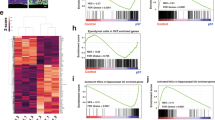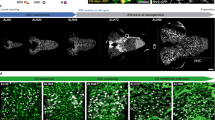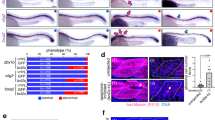Abstract
Specialized cellular microenvironments, or ‘niches’, modulate stem cell properties, including cell number, self-renewal and fate decisions1,2. In the adult brain, niches that maintain a source of neural stem cells (NSCs) and neural progenitor cells (NPCs) are the subventricular zone (SVZ) of the lateral ventricle and the dentate gyrus of the hippocampus3,4,5. The size of the NSC population of the SVZ at any time is the result of several ongoing processes, including self-renewal, cell differentiation, and cell death. Maintaining the balance between NSCs and NPCs in the SVZ niche is critical to supply the brain with specific neural populations, both under normal conditions or after injury. A fundamental question relevant to both normal development and to cell-based repair strategies in the central nervous system is how the balance of different NSC and NPC populations is maintained in the niche. EGFR (epidermal growth factor receptor) and Notch signalling pathways have fundamental roles during development of multicellular organisms6. In Drosophila and in Caenorhabditis elegans these pathways may have either cooperative or antagonistic functions7,8,9. In the SVZ, Notch regulates NSC identity and self-renewal, whereas EGFR specifically affects NPC proliferation and migration10,11,12,13. This suggests that interplay of these two pathways may maintain the balance between NSC and NPC numbers. Here we show that functional cell–cell interaction between NPCs and NSCs through EGFR and Notch signalling has a crucial role in maintaining the balance between these cell populations in the SVZ. Enhanced EGFR signalling in vivo results in the expansion of the NPC pool, and reduces NSC number and self-renewal. This occurs through a non-cell-autonomous mechanism involving EGFR-mediated regulation of Notch signalling. Our findings define a novel interaction between EGFR and Notch pathways in the adult SVZ, and thus provide a mechanism for NSC and NPC pool maintenance.
This is a preview of subscription content, access via your institution
Access options
Subscribe to this journal
Receive 51 print issues and online access
$199.00 per year
only $3.90 per issue
Buy this article
- Purchase on SpringerLink
- Instant access to full article PDF
Prices may be subject to local taxes which are calculated during checkout




Similar content being viewed by others
References
Mercier, F., Kitasako, J. T. & Hatton, G. I. Anatomy of the brain neurogenic zones revisited: fractones and the fibroblast/macrophage network. J. Comp. Neurol. 451, 170–188 (2002)
Alvarez-Buylla, A. & Lim, D. A. For the long run: maintaining germinal niches in the adult brain. Neuron 41, 683–686 (2004)
Doetsch, F., Caillé, I., Lim, D. A., García-Verdugo, J. M. & Alvarez-Buylla, A. Subventricular zone astrocytes are neural stem cells in the adult mammalian brain. Cell 97, 703–716 (1999)
Palmer, T. D., Willhoite, A. R. & Gage, F. H. Vascular niche for adult hippocampal neurogenesis. J. Comp. Neurol. 425, 479–494 (2000)
Temple, S. The development of neural stem cells. Nature 414, 112–117 (2001)
Sundaram, M. V. The love-hate relationship between Ras and Notch. Genes Dev. 19, 1825–1839 (2005)
Kumar, J. P. & Moses, K. The EGF receptor and notch signaling pathways control the initiation of the morphogenetic furrow during Drosophila eye development. Development 128, 2689–2697 (2001)
Yoo, A. S., Bais, C. & Greenwald, I. Crosstalk between the EGFR and LIN-12/Notch pathways in C. elegans vulval development. Science 303, 663–666 (2004)
Hasson, P. et al. EGFR signaling attenuates Groucho-dependent repression to antagonize Notch transcriptional output. Nature Genet. 237, 101–105 (2005)
Hitoshi, S. et al. Notch pathway molecules are essential for the maintenance, but not the generation, of mammalian neural stem cells. Genes Dev. 16, 846–858 (2002)
Alexson, T. O., Hitoshi, S., Coles, B. L., Bernstein, A. & van der Kooy, D. Notch signaling is required to maintain all neural stem cell populations—irrespective of spatial or temporal niche. Dev. Neurosci. 28, 34–48 (2006)
Lillien, L. & Raphael, H. BMP and FGF regulate the development of EGF-responsive neural progenitor cells. Development 127, 4993–5005 (2000)
Breunig, J. J., Silbereis, J., Vaccarino, F. M., Sestan, N. & Rakic, P. Notch regulates cell fate and dendrite morphology of newborn neurons in the postnatal dentate gyrus. Proc. Natl Acad. Sci. USA 104, 20558–20563 (2007)
Aguirre, A., Dupree, J. L., Mangin, J. M. & Gallo, V. A functional role for EGFR signaling in myelination and remyelination. Nature Neurosci. 10, 990–1002 (2007)
Aguirre, A., Rizvi, T. A., Ratner, N. & Gallo, V. Overexpression of the epidermal growth factor receptor confers migratory properties to nonmigratory postnatal neural progenitors. J. Neurosci. 25, 11092–11106 (2005)
Steiner, B. et al. Type-2 cells as link between glial and neuronal lineage in adult hippocampal neurogenesis. Glia 54, 805–814 (2006)
Doetsch, F., García-Verdugo, J. M. & Alvarez-Buylla, A. Cellular composition and three-dimensional organization of the subventricular germinal zone in the adult mammalian brain. J. Neurosci. 17, 5046–5061 (1997)
Capela, A. & Temple, S. Lex/ssea-1 is expressed by adult mouse CNS stem cells, identifying them as non-ependymal. Neuron 35, 865–875 (2002)
Aguirre, A. & Gallo, V. Postnatal neurogenesis and gliogenesis in the olfactory bulb from NG2-expressing progenitors of the subventricular zone. J. Neurosci. 24, 10530–10541 (2004)
Jablonska, B. et al. Cdk2 is critical for proliferation and self-renewal of neural progenitor cells in the adult subventricular zone. J. Cell Biol. 179, 1231–1245 (2007)
Gaiano, N., Nye, J. S. & Fishell, G. Radial glial identity is promoted by Notch1 signaling in the murine forebrain. Neuron 26, 395–404 (2000)
Mizutani, K., Yoon, K., Dang, L., Tokunaga, A. & Gaiano, N. Differential Notch signalling distinguishes neural stem cells from intermediate progenitors. Nature 449, 351–355 (2007)
Lim, D. A. et al. Noggin antagonizes BMP signaling to create a niche for adult neurogenesis. Neuron 28, 713–726 (2000)
Colak, D. et al. Adult neurogenesis requires Smad4-mediated bone morphogenic protein signaling in stem cells. J. Neurosci. 28, 434–446 (2008)
Lai, K., Kaspar, B. K., Gage, F. H. & Schaffer, D. V. Sonic hedgehog regulates adult neural progenitor proliferation in vitro and in vivo. Nature Neurosci. 6, 21–27 (2003)
Kohyama, J. et al. Visualization of spatiotemporal activation of Notch signaling: live monitoring and significance in neural development. Dev. Biol. 286, 311–325 (2005)
Aguirre, A. & Gallo, V. Reduced EGFR signaling in progenitor cells of the adult subventricular zone attenuates oligodendrogenesis after demyelination. Neuron Glia Biol. 3, 209–220 (2007)
McGill, M. A. & McGlade, C. J. Mammalian numb proteins promote Notch1 receptor ubiquitination and degradation of the Notch1 intracellular domain. J. Biol. Chem. 278, 23196–23203 (2003)
Chapman, G., Liu, L., Sahlgren, C., Dahlqvist, C. & Lendahl, U. High levels of Notch signaling down-regulate Numb and Numblike. J. Cell Biol. 175, 535–540 (2006)
Ling, B. C. et al. Role for the epidermal growth factor receptor in neurofibromatosis-related peripheral nerve tumorigenesis. Cancer Cell 7, 65–75 (2005)
Wehner, T. et al. Bone marrow-derived cells expressing green fluorescent protein under the control of the glial fibrillary acidic protein promoter do not differentiate into astrocytes in vitro and in vivo. J. Neurosci. 23, 5004–5011 (2003)
Luetteke, N. C. et al. The mouse waved-2 phenotype results from a point mutation in the EGF receptor tyrosine kinase. Genes Dev. 8, 399–413 (1994)
Morshead, C. M., Craig, C. G. & van der Kooy, D. In vivo clonal analyses reveal the properties of endogenous neural stem cell proliferation in the adult mammalian forebrain. Development 125, 2251–2261 (1998)
Matsuda, T. & Cepko, C. L. Controlled expression of transgenes introduced by in vivo electroporation. Proc. Natl Acad. Sci. USA 104, 1027–1032 (2007)
Galceran, J., Sustmann, C., Hsu, S. C., Folberth, S. & Grosschedl, R. LEF1-mediated regulation of Delta-like1 links Wnt and Notch signaling in somitogenesis. Genes Dev. 18, 2718–2723 (2004)
Ohtsuka, T. et al. Visualization of embryonic neural stem cells using Hes promoters in transgenic mice. Mol. Cell. Neurosci. 31, 109–122 (2006)
Kolev, V. et al. The intracellular domain of Notch ligand Delta1 induces cell growth arrest. FEBS Lett. 579, 5798–5802 (2005)
Belachew, S. et al. Postnatal NG2 proteoglycan-expressing progenitor cells are intrinsically multipotent and generate functional neurons. J. Cell Biol. 161, 169–186 (2003)
Acknowledgements
We thank N. Ratner for the Cnp–hEGFR mice. We are thankful to T. Hawley for technical advice in all FACS sorting experiments. We are grateful to J. Corbin and T. Haydar for critically reading this manuscript, and to all our colleagues at the Center for Neuroscience Research for discussion and support. We are thankful to N. Gaiano for discussion, for providing reagents and for his continuous advice on this project. We thank G. Corfas, A. Israel, C. L. Cepko, R. Kopan, R. Grosschedl, N. Gaiano and R. Kageyama for the gift of CBF-1, Hes1–GFP, Hes1-dsRED, Notch constructs, Dll–GFP, CBFRE–EGFP and Hes5–GFP, respectively. This work was supported by NIH R01NS045702 and R01NS056427 (V.G.), K99NS057944 (A.A.), ROO NS057944-03 (A.A.) and by NIH IDDRC P30HD40677 (V.G.). Electron microscopy was performed at the University of Connecticut, Department of Physiology and Neurobiology, with funding from NIH R01DC006881 to M.E.R., and from NSF DBI-0420580 for funds to purchase the Tecnai 12 Biotwin electron microscope.
Author information
Authors and Affiliations
Contributions
A.A. performed all the experiments. M.E.R. performed the electron microscopy studies. A.A. and V.G. designed all experiments. V.G. supervised the entire project. A.A. and V.G. wrote the manuscript.
Corresponding author
Ethics declarations
Competing interests
The authors declare no competing financial interests.
Supplementary information
Supplementary Information
This file contains Supplementary Figures 1-14 with legends and Supplementary Table 1. (PDF 18408 kb)
Rights and permissions
About this article
Cite this article
Aguirre, A., Rubio, M. & Gallo, V. Notch and EGFR pathway interaction regulates neural stem cell number and self-renewal. Nature 467, 323–327 (2010). https://doi.org/10.1038/nature09347
Received:
Accepted:
Issue Date:
DOI: https://doi.org/10.1038/nature09347



